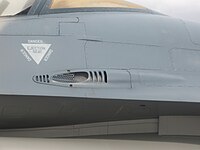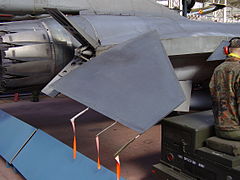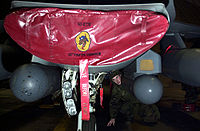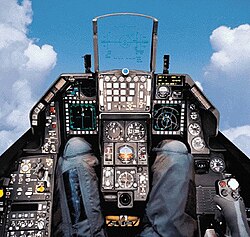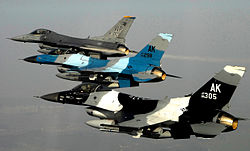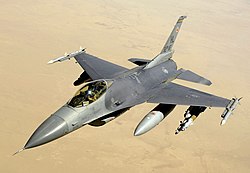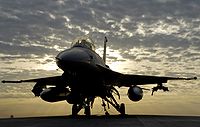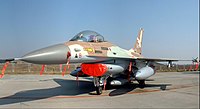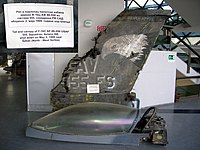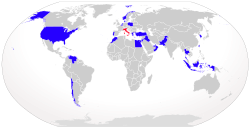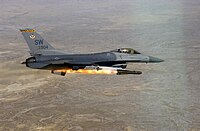Lockheed Martin F-16 Fighting Falcon
The F-16 Fighting Falcon is a single-engine multipurpose fighter developed by the American company General Dynamics in the 1970s for the United States Air Force; it entered service in 1978. Although it was originally designed as a light fighter in accordance with visual flight rules by day, it evolved into a multi-role fighter. In 1993 the Fighting Falcon changed manufacturers, since that year General Dynamics sold its aircraft production company to the Lockheed company, which today is Lockheed Martin after its 1995 merger with Martin Marietta. Although no longer it is built for the US Air Force, production is still active for export. The aircraft has also been built under license in other countries, including Belgium, South Korea, the Netherlands and Turkey.
The Fighting Falcon is a specialized close combat aircraft that introduced many innovations, including a frameless bubble cockpit for better visibility, side stick for better control under high G forces, and the reclined seat to reduce the effect of G-forces on the pilot. It is the first combat aircraft purposely built to withstand 9 G turns. Its good thrust-to-weight ratio gives it power to even climb and accelerate vertically, if necessary. To carry out its missions, it has an internal automatic cannon M61 Vulcan and up to 11 external mounts to mount various types of missiles, bombs, supplemental fuel tanks and pods (avionics containers, countermeasures, etc.).
The F-16 has achieved great success in the export market, having been selected to serve in the air forces of twenty-five countries. It became the largest jet fighter aviation program in the West, with more than 4,570 aircraft built since its production began in 1976. It has participated in numerous conflicts, especially in the Balkans and the Middle East. This aircraft can also be seen in two aerobatics groups; the United States Thunderbirds, since 1983, and the Singapore Black Knights, since 2000. Although the official name of the F-16 is Fighting Falcon (which in English means "fighting falcon" or "fighting hawk"), is also well known by the nickname Viper ("viper").
The F-16 is scheduled to remain in service with the United States Air Force until 2025. Its replacement aircraft is the Lockheed Martin F-35 Lightning II, which entered service in 2015 and will it will gradually replace.
Development
Origin
Experience in the Vietnam War revealed several flaws in the capabilities of American fighters, primarily the F-4 Phantom II, and showed that neither those planes nor their pilots were prepared for close air combat. This need for new air superiority fighters led the United States Air Force (USAF) to initiate two projects in 1965 to develop new high-performance aircraft: the FX program (abbreviation in English for Fighter Experimental, in Spanish «experimental fighter») that sought a twin-engine design of the order of 20 tons with a variable geometry wing, advanced avionics and long-range missiles; and the ADF program (Advanced Day Fighter), with expectations of designing a light fighter weighing around 11 tons that could exceed the performance of the Soviet MiG-21 by 25 percent. However, in July 1967 the MiG-25 appeared, with the capacity to reach speeds close to Mach 3. In view of such an event, the United States Department of Defense gave priority to the FX program, which led to the F-15 Eagle, and the ADF program was postponed.
LWF Program
An informal but influential group called the "Fighter Mafia," led by systems analyst Pierre Sprey, test pilot Charles E. Meyers, and fighter pilot Adolfo Giampaoli, believed the F-15 program was going badly. path; it was still a large aircraft, not especially suited for short-range combat. In addition, he believed that the Air Force's need was for a new, cheap, and highly maneuverable light fighter, while the USAF insisted that the priority was the F-15. However, support for the Fighter Mafia was increasing in Congress and in the Secretary of Defense. Thus, on January 16, 1971, Deputy Secretary of Defense David A. Packard began the LWF (Lightweight Fighter) program to evaluate the possibilities of such an aircraft.
The LWF program was initially looking for an aircraft with a weight of 9,000 kg, low cost, very high performance below Mach 1.6 and a good thrust/weight ratio. At first it was only born to establish to what degree a small and cheap fighter could be developed, but its potential for export and for the replacement of the F-104 Starfighter was quickly seen. Packard advocated the competition model, in which two models would be chosen to make the prototypes and the winner would be chosen from among them. Manufacturers Boeing, General Dynamics, LTV, and Rockwell proposed single-engine aircraft, while Northrop followed suit with a twin-engine design. Despite the fact that the proposals from Boeing and General Dynamics were the best, the two aircraft chosen for the competition were those from General Dynamics and Northrop, since the countries interested in purchasing this new aircraft were interested in a twin-engine as a result of the numerous accidents suffered by the single-engine F-104.
Prototypes
On April 13, 1972, the General Dynamics 401 and Northrop P.530 models were chosen, being redesignated YF-16 and YF-17 respectively. While the YF-17 was a relatively conventional aircraft, the YF-16 was an entirely new design, featuring numerous technological innovations such as fly-by-wire flight controls, instability, and cockpit control. advanced flight.
The first flight of the YF-16 prototype took place at Edwards Air Force Base, California on January 21, 1974, although it was an unexpected first flight. During that day the tests were high speed taxiing, but at 222 km/h the plane began to oscillate violently and pilot Phil Oestricher decided to rise to avoid going off the runway and then land again. The first planned flight occurred on February 2 of that same year, in which the aircraft managed to climb up to 9,000 m and reached speeds of more than 600 km/h. The second prototype flew on March 9, 1974.
There was still rejection of the LWF program within the Air Force, since it was seen as a threat to the F-15. The program was renamed ACF (Air Combat Fighter) in April 1974 to lower opposition. Meanwhile, four NATO countries (Belgium, Denmark, the Netherlands and Norway) were interested in looking for an aircraft to replace their F-104. Among the options studied were the Mirage F1, the Saab Viggen and the two ACFs. The winner of the ACF program would probably be chosen, but the four countries wanted to know if the USAF was going to buy it. In October 1974 Secretary of Defense James R. Schlesinger announced the Air Force's intention to purchase 600 units, with the possibility of expanding it to 1,400 or more.
On January 13, 1975, the YF-16 was chosen as the winner of the ACF for being more maneuverable, cheaper and having a longer range. Another reason given by the USAF was that the YF-16 used the Pratt & Whitney F100; the same as the F-15. There were also political reasons as, with the end of series production of the F-111 supersonic bomber, the future of General Dynamics was in question.
Evolution
After being selected, the YF-16 prototype design was altered for series production of the F-16. The fuselage was lengthened by 26.9 cm, the nose radome was changed to a larger one to house the AN/APG-66 radar, the wing area was increased from 26 to 28 m², the height of the vertical stabilizer was significantly reduced, the ventral fins were lengthened, two more storage compartments were added, and the original double door for the front wheel was replaced by a single side-hinged door. These modifications caused the weight of the F-16 to increase by about 35% compared to the YF-16 prototypes.
Another necessary change that had originally been overlooked was caused by the need for more pitch control to avoid stall conditions at large angles of attack. Tests on models of the YF-16 carried out by the Langley Research Center had found the possible problem, but no other laboratory had been able to reproduce it. Flight testing of the YF-16 had not been extensive enough to resolve the issue, but relevant flight testing with FSD pre-production aircraft showed that it was a genuine concern. As a result, the area of the horizontal stabilizers was increased by 25%; this "big tail" was introduced in Block 15 in 1981 and later applied to aircraft that had already been produced previously. In addition to significantly reducing (but not eliminating) the risk of stalling, larger stabilizers also improve stability and allow for faster takeoff roll.
In the 1980s the MSIP (Multinational Staged Improvement Program) program was carried out to develop new capabilities for the F-16, mitigate risks during technology upgrades, and ensure their validity in a changing threat environment. The program modernized the F-16 in three stages. Overall, the MSIP process allowed for rapid introduction of new capabilities, at low cost, and with reduced risk compared to traditional systems upgrades and modernization programs. The F-16 was involved in other enhancement programs and upgrade programs. service life extension in the first decade of the 2000s.
Production
Manufacturing of pre-production F-16 FSD aircraft began at General Dynamics' Fort Worth plant in Texas in late 1975. The first example, a single-seat F-16A, left the factory on October 20, 1976, and made its maiden flight on December 8 of that year. The first two-seater model carried out its maiden flight on August 8, 1977. The initial production standard model first flew on August 7, 1978 and was accepted for delivery by the United States Air Force on January 6. The F-16 received its formal nickname "Fighting Falcon" on July 21, 1980, and entered operational USAF service with the 388th Tactical Fighter Wing at Hill Air Force Base on October 1. from 1980.
On June 7, 1975, during the Paris Air Show, the four European partners, now known as the European Participation Group, signed up to purchase 348 combat aircraft. These were distributed among the European Participation Air Forces or EPAF (European Participation Air Forces) in 116 for Belgium, 58 for Denmark, 102 for the Netherlands, and 72 for Norway. They would be manufactured on two European production lines: one at Fokker's Schiphol-Oost facility in the Netherlands, and the other at SABCA's Gossellies plant in Belgium. Production would be divided into 184 and 164 units respectively. The Norwegian company Kongsberg Vaapenfabrikk and the Danish Terma A/S also manufactured parts and made sub-assemblies for the EPAF apparatus. The European co-production was officially launched on July 1, 1977 at the Fokker factory. In mid-November 1977, Fokker-produced components to assemble airframes began to be shipped to Fort Worth, which were returned again to Europe (this process with SABCA began in January 1978); final assembly of EPAF aircraft began at the Belgian plant on 15 February 1978, with deliveries to the Belgian Air Force beginning in January 1979. The Dutch line went online in April 1978 and delivered its first aircraft to the Royal Netherlands Air Force in June 1979. In 1980 the first fighter was delivered to the Royal Norwegian Air Force by SABCA, and to the Royal Danish Air Force by Fokker. These countries in the European participation group increased their fleets of F-16 aircraft subsequently with more orders.
One more production line has since been established in Ankara, Turkey, where since the late 1980s and through the 1990s, Turkish Aerospace Industries (TAI) has produced under license 232 F-16 Block 30/40/50 for the Turkish Air Force, and 30 Block 50 Advanced units are in operation by 2010. TAI also manufactured 46 Block 40 aircraft. i> for Egypt in the mid-1990s. Korean aerospace company Korean Aerospace Industries (KAI) opened another production line for the Republic of Korea Air Force's KF-16 program, producing 140 Block aircraft. 52 from the mid-1990s to the mid-2000s. If India selects the new F-16IN to get its medium multi-role fighter aircraft in the MRCA program, a sixth production line of the F-16IN would be established. 16 in that country to produce at least 108 fighters.
Design
Overview
The F-16 is a multi-role, supersonic, single-engine tactical aircraft. It was designed to be a cost-effective "workhorse" that could perform various types of missions and stay constantly ready. It is much smaller and lighter than its predecessors, but employs advanced avionics and aerodynamics, as well as being the first to employ a relaxed static stability/fly-by-wire (RSS/FBW) flight control system, for improved flight performance. maneuvers. Extremely agile, the Fighting Falcon can pull maneuvers at 9 G's and can reach a top speed in excess of Mach 2.
The F-16 is equipped with a 20mm M61 Vulcan autocannon in the left wing pod: the F-16A is distinguished by having four vents behind the M61 cannon bore, while the subsequent F-16C it only has two vents.
Early models could be armed with up to six AIM-9 Sidewinder infrared-guided short-range air-to-air missiles (AAMs), including one missile mounted on a dedicated launcher rail on each wingtip. Some variants can also employ the AIM-7 Sparrow radar-guided medium-range AAM, and newer versions can be fitted with the modern AIM-120 AMRAAM. You can also use other AAMs; a wide variety of air-to-surface missiles, rockets or bombs; electronic countermeasures (ECM), navigation, targeting, or weapons containers; and external fuel tanks at up to eleven hardpoints—six under the wings, two at the tips of the wings, and three under the fuselage.
General Settings
The F-16 design employs a chopped delta wing shape, incorporating fairing of the wing-fuselage socket and leading edge extensions for vortex control at the front; a fixed geometry ventral air intake for the intake of the turbofan engine; a conventional three-plane tail arrangement with fully movable horizontal stabilizers; a pair of ventral fins under fuselage just behind trailing edge of wings; one-piece bubble cabin; and landing gear in a tricycle configuration with the retractable front steering wheel housed below the air intake duct, and deploying just aft of the intake lip. It has a receptacle for in-flight refueling with a boom located some distance behind the cockpit. Its two dual-fin speedbrakes are located between the tail horizontal stabilizers and the engine nozzle, as the rear termination of the wing-fuselage pods, and the arresting hook is mounted under the aft of the fuselage.
At the base of the vertical tail stabilizer it has another fairing, used to house various elements such as ECM devices or drag chutes. Some later models of the F-16, such as the F-16I Block 50 variant, also feature a bulging dorsal fairing that runs along the "spine" of the fuselage from the rear of the flight deck to the tail fairing. This extra space can be used to house additional equipment or fuel.
The F-16 was designed to be relatively inexpensive to build and much simpler to maintain than previous generation fighter jets. Its structure is composed of approximately 80% aluminum alloys, 8% steel, 3% composite materials, and 1.5% titanium. Control surfaces, such as the leading edge flaps, ailerons, and ventral flaps, make extensive use of aluminum honeycomb panel structural elements and fiberglass-reinforced polymer laminate skin. carbon. The F-16A has 228 access panels throughout the aircraft, around 80% of which are directly accessible. The number of lubrication points, fuel line connections, and replaceable modules has also been greatly reduced compared to its predecessors.
Although the USAF LWF program had required an aircraft structural life of only 4,000 flight hours, and the ability to achieve 7.33G on 80% internal fuel, General Dynamics engineers They decided early on to design the airframe for the F-16 with a life of up to 8,000 hours and for maneuvering at 9G with a full internal tank. This proved to be an advantage when the aircraft's mission changed from pure air-to-air combat to multi-role operations. However, changes made beyond planned operational use and the continued increase in weight due to the addition of more systems have required various structural strengthening programs.
Flight controls
Negative static stability
The YF-16 was the world's first aircraft intentionally designed to be slightly unstable aerodynamically. This technique, called "relaxed static stability" (in English RSS or relaxed static stability), was incorporated to increase the fighter's maneuverability. Most aircraft are designed with positive static stability, which induces the aircraft to return to its original attitude. However, the positive static stability makes the aircraft's maneuverability difficult, since the tendency to continue in its current attitude opposes the pilot's effort to maneuver; on the other hand, an aircraft with negative static stability will be, in the absence of control input, ready to change level and abandon stable flight. Consequently, an aircraft with negative static stability will be more maneuverable than one that is positively stable.
Electronic flight controls
To counteract this tendency to drift out of controlled flight and avoid the need for constant trimming movements by the pilot, the F-16 features a four-channel electronic flight control system of the fly- by-wire (FBW). The flight control computer, which is a key component of the system, accepts commands from the pilot through the control stick and rudder pedals, and manipulates the control surfaces in such a way as to produce the resulting desired maneuver. without losing control (known as "going out" of controlled flight). The flight control computer also takes thousands of measurements per second of the aircraft's attitude, and automatically makes corrections to compensate for deviations and maintain the flight path without the need for pilot intervention, thereby enabling stable flight. This has spawned a common aphorism among F-16 pilots: “You don't fly an F-16; he flies you."
Flight deck
One of the most notable features of the F-16 from a pilot's perspective is the exceptional field of view from the cockpit, a feature that is vital during air-to-air combat. Birdproof, one-piece polycarbonate bubble cockpit provides full 360° visibility, with a downward viewing angle of 40° on the sides and 15° on the nose (12° was most common on its predecessors). -13°); to achieve this the pilot's seat is mounted in a raised position. Also, unlike most fighters, the F-16's canopy does not have any structural arches that would obstruct part of the pilot's vision. However, the excessive length of the tandem configuration of two-seat F-16s necessitates a structural arch between the pilots.
The rocket-powered ACES II zero-zero ejection seat mounted on the F-16 is tilted back at an unusual 30° angle, as seats in older or contemporary fighters used to have a near-back tilt at 13-15°. The large bank angle was chosen to increase the pilot's tolerance for high G-forces, and to reduce their susceptibility to G-force-induced loss of consciousness. The greater seat angle, however, has also been associated with greater risk of neck pain when not mitigated by proper use of the headrest. Subsequently, subsequent US fighter aircraft designs shifted to a more moderate bank angle of 20°. Due to excessive seat angle and polycarbonate canopy thickness, the F-16's ejection seat lacks the cockpit-breaking steel rails found in most other aircraft ejection systems. On the F-16, crew ejection is performed after shedding the canopy: when relative wind rips the cockpit away from the aircraft, a cable actuates the rockets to propel the seat.
The pilot flies the aircraft primarily by means of an armrest-mounted side control stick on the right side (rather than the more usual center control stick), and an engine throttle stick on the left side, along with with conventional rudder pedals. To increase the degree of pilot control over the aircraft during high-G warp manoeuvres, several of the function switches that were previously distributed throughout the cockpit have been changed to HOTAS-type controls, to be accessible without removing hands from the control stick. throttle and control lever. Simple hand pressure on the control stick causes the transmission of electrical signals through the fly-by-wire (FBW) system, which regulate the various flight control surfaces used for maneuvering. Originally the control stick was fixed, but that configuration proved awkward and difficult for pilots to adjust to, sometimes tending to over-rotate the aircraft during takeoffs, so the stick was given a small amount of " game". Since its introduction on the F-16, HOTAS controls have become a standard feature of modern fighters, whereas the side stick application is less widespread.
The cockpit of the F-16 has a head-up display (HUD) type data screen, which projects visual information, both flight and combat information, in front of the pilot symbolic and without obstructing your view. This allows you to see the data overlaid at eye level and keep your eyes out of the cockpit, as well as improving the pilot's situational awareness of what is happening around them. The JHMCS Helmet Mounted Sight System (Joint Helmet Mounted Cueing System) is also available on the F-16 from Block 52 onwards, for use with advanced air-to-air missiles such as the AIM-9X. The JHMCS allows the weapon system to be guided in the direction the pilot's head is looking, even outside the field of view offered by the HUD, while maintaining situational awareness. The JHMCS was first deployed operationally during Invasion. of Iraq in 2003.
The pilot obtains more information about the flight and the status of the systems through the multifunction displays (MFD). The left-hand MFD is the main flight display (PFD), which typically displays the moving map and radar imagery; the MFD on the right side is the system display or SD (system display), which presents important information about the engine, landing gear, slats positions and flaps, amount of fuel, and weapons status. Initially, the F-16A/B only had a single monochrome cathode ray tube (CRT) display used as a PFD, and system information was provided by various traditional control instruments. The Mid Life Update (MLU) introduced the MFD SD display in a cockpit, which became compatible with the use of night vision goggles. Those CRT displays were replaced by liquid crystal displays at color in Block 50/52. Block 60 offers three programmable and interchangeable color MFDs (CMFDs) with "picture-in-picture" capability, capable of overlaying the full display of the tactical situation on the moving map.
Radar
The F-16A/B was originally equipped with Westinghouse Electronic Systems' (now Northrop Grumman) AN/APG-66 Pulse Doppler Fire Control Radar. Its flat directional antenna was designed to be compact enough to fit inside the relatively small nose of the F-16. The APG-66 radar uses a low pulse repetition frequency (PRF) for medium and high altitude target detection in a low clutter environment, and a medium PRF for dense clutter environments. It has four operating frequencies within the X band, and provides four operating modes for air-to-air combat and seven for air-to-ground combat, even at night or in adverse weather conditions. The Block 15 model APG-66(V)2 added a new, more powerful signal processor, with higher output power, improved reliability, and longer range in environments with clutter or caused interference. The MLU half-life upgrade program upgraded this to the APG-66(V)2A model, which offers faster processing speed and more memory.
]]
The AN/APG-68 radar, an evolution of the APG-66, was introduced with the F-16C/D Block 25. This radar model has greater range and resolution, as well as 25 modes of operation, including plotting of terrestrial maps, Doppler beam-sharpening, moving target on land, target at sea, and track-while-scanning (TWS) for up to ten targets. The Block 40/42 APG-68(V)1 model added full compatibility with Lockheed Martin's LANTIRN devices, and a high PRF tracking mode to provide continuous wave (CW) target illumination for radar-guided missiles. semi-active like the AIM-7 Sparrow. The F-16 Block 50/52 initially received the more reliable APG-68(V)5 version, which has a programmable signal processor using VHSIC technology. Block 50/52 Advanced (or 50+/52+) are equipped with the upgraded APG-68(V)9 radar, which has a 30% greater air-to-air detection range, and a synthetic aperture radar mode (SAR) for reconnaissance, target detection and high-resolution mapping. In August 2004, Northrop Grumman received a contract to begin upgrading APG-68 radars on Block 40/42/50/52 aircraft to the (V)10 standard, which equips the F-16 with all-weather autonomous search and detection. for the use of precision weapons with the help of the global positioning system (GPS). It also incorporates SAR and Terrain Tracking (TF) mapping modes, as well as interleaving of all modes.
The F-16E/F became equipped with the advanced AN/APG-80 Active Electronically Scanned Radar (AESA) also from Northrop Grumman, giving the aircraft the ability to track and destroy ground and airborne threats simultaneously, becoming the third fighter equipped with that type of technology.
In July 2007, Raytheon announced that it is developing a new radar called Raytheon Next Generation Radar (RANGR) based on its earlier AN/APG-79 AESA radar as an alternative candidate to the AN/APG-68 and AN/APG -80 from Northrop Grumman for newly manufactured F-16s, and also as a technical upgrade to existing ones.
Propulsion
The propulsion system initially selected for this single-engine aircraft was the Pratt & Whitney F100-PW-200 with afterburner, a slightly modified version of the F100-PW-100 used by the F-15 Eagle. With a maximum thrust force of 106 kN (23,830 lbf) with afterburning, that model continued as the standard F-16 engine through the Block 25, except for newly manufactured Block 15s with OCU Operational Capability Upgrade ( Operational Capability Upgrade). The OCU introduced the 105.7 kN (23,770 lbf) F100-PW-220, which was also fitted to Block 32 and 42 aircraft. Although it does not offer a noticeable difference in power, this Reactor introduced a Digital Electronic Engine Control (DEEC) unit that improved reliability and reduced the risk of engine stalls (an occasional nasty trend with the original "- 200" which when it occurred forced to restart the engine in the air). Introduced to the F-16 production line in 1988, the "-220" also replaced the "-100" of the F-15, thus maximizing standardization. Many of the "-220" of Block 25 and later aircraft were upgraded beginning in mid-1997 to the "-220E" standard. With increased reliability and better maintainability, this model achieved a 35% reduction in the rate of unplanned thruster changes.
| Versions | Blocks | Motor | Push max. |
|---|---|---|---|
| F-16A/B | 1 - 20 | PW F100-PW-200 | 106 kN |
| F-16C/D | 25, 32, 42 | PW F100-PW-220E | 105.7 kN |
| 30, 40 | GE F110-GE-100 | 128.9 kN | |
| 50 | GE. F110-GE-129 | 131.6 kN | |
| 52 | PW F100-PW-229 | 129.4 kN | |
| F-16E/F | 60 | GE F110-GE-132 | 144.6 kN |
The development of the F100-PW-220/220E engines was the result of the AFE (Alternate Fighter Engine) program undertaken by the USAF (colloquially known as the Great Engine War, in Spanish "the great engine war"), which also led to the entry of General Electric as a supplier of engines for the F-16. General Electric's new F110-GE-100 turbofan, however, required modification of the F-16's intake; the original air intake limited the maximum thrust of GE jets to just 114.5 kN (25,735 lbf), while the new Modular Common Inlet Duct ) enabled the F110 to achieve its maximum thrust of 128.9 kN (28,984 lbf). To distinguish between aircraft equipped with these two engines and air intakes, starting with Block 30, blocks ending in "0" (eg Block 30) are powered by General Electric, and blocks ending in "2" (eg Block 32) are equipped with Pratt & Whitney.
Efforts to improve engines by the two competitors under the Increased Performance Engine (IPE) program led to the development of the F110-GE-129 of 131, 6 kN (29,588 lbf) for Block 50 and the 129.4 kN (29,100 lbf) F100-PW-229 for Block 52. F-16s began flying with those IPE engines on October 22, 1991, and October 22, 1992, respectively. Overall, of the 1,446 F-16C/D fighters purchased by the U.S. Air Force, 556 were equipped with F100-series engines, and 890 with F110-series engines. UAE Block 60 aircraft are powered by the General Electric F110-GE-132 turbofan, which with a maximum thrust of 144.6 kN (32,500 lbf), is the most powerful jet equipped on an F-16.
F-16V Components
Structure
Electronics
Weaponry
Propulsion
Main production variants
Over the years, to gradually improve the F-16 and bring the aircraft in service up to date, a variety of structural, weapons carrier, systems, hardware and software upgrades have been made to it. F-16 models are denoted by sequential block numbers (production lines) indicating major upgrades. These blocks cover the single-seater versions and the two-seater versions.
While most F-16s were produced based on these block designs, there are many other variants with significant changes, usually due to modification programs. Other modifications have resulted in specialization in a given mission, such as close air support and reconnaissance variants, and various models have also been developed to test new technologies. In addition, the F-16 has inspired the design of other aircraft that are considered derivatives of the F-16.
F-16A/B
The F-16A (single-seat) and F-16B (two-seat) were initially equipped with the Westinghouse AN/APG-66 pulsed Doppler radar, and the Pratt & Whitney F100-PW-200, which gave the aircraft 64.9 kN (14,670 lbf) of dry thrust and 106 kN (23,830 lbf) with afterburner. Variants A and B include Blocks 1, 5, 10, 15, and 20. The USAF acquired 674 F-16As and 121 F-16Bs, with deliveries completed in March 1985.
The first blocks, Blocks 1, 5 and 10, offered relatively minor changes. Most of these aircraft were all later upgraded to the Block 10 configuration in the early 1980s. The Block 15 was the first major change to the F-16: this model featured larger horizontal stabilizers, the addition of two-point anchorage in the air intake, an improved AN/APG-66(V)2 radar, and a greater capacity in the underwing supports. Block 15 also obtained the UHF radio for secure communications using Have Quick II (frequency hopping spread spectrum system). The stabilizers were increased by about 30% to counteract the additional weight of the new anchor brackets. Block 15 is the variant produced in the greatest number, with 983 units manufactured.
Block 20 added some capabilities of the F-16C/D: improved AN/APG-66(V)3 radar, ability to carry AGM-45 Shrike, AGM-84 Harpoon, and AGM-88 HARM missiles, as well as the LANTIRN navigation and target finding system. The Block 20 computers were significantly improved compared to those of the first examples.
The average unit cost of an F-16A/B was $14.6 million in 1992.
F-16C/D
The F-16C (single-seater) and F-16D (two-seater) variants entered service in 1984. The Block 25 was the first of the C/D models. Added all-weather capabilities for "beyond vision" range air-to-air missiles; (BVR). It also provided a substantial improvement in avionics for the flight deck, and the new AN/APG-68 radar. The Block 25 aircraft were delivered with the Pratt & Whitney F100-PW-200 and later updated with the Pratt & Whitney F100-PW-220E. A total of 209 Block 25 devices were delivered.
The Block 30/32 was the first of the F-16s affected by the alternative engine project AFE (Alternative Fighter Engine) under which it was equipped with the traditional Pratt & Whitney or, for the first time, with the General Electric F110-GE-100. From this point on, blocks ending in "0" (eg Block 30) are powered by General Electric, and blocks ending in "2" (eg Block 32) are equipped with Pratt & Whitney. The first F-16 Block 30 entered service in 1987. The biggest difference lies in the ability to carry the AGM-45 Shrike, AGM-88 HARM, and AIM-120 AMRAAM missiles. Due to the greater power of the GE engine, starting in Block 30 the F-16 was equipped with an intake duct for a larger engine, called the Modular Common Inlet Duct. A total of 733 Block 30/32 fighters were produced and delivered to six countries.
The Block 40/42 entered service in 1988. This is the improved variant for all-weather attack, equipping the LANTIRN system. Also unofficially designated the F-16CG/DG, the night capability led to these aircraft being nicknamed "Night Falcons" (in Spanish: "nighthawks"). The characteristics that this block incorporates are an elongated and reinforced landing gear that allows mounting the LANTIRN pods on the sides of the air intake, an improved radar, and a GPS receiver. Since 2002, the range of weaponry available for Block 40/42 was expanded with the batch added in Block 50/52, and also with the GBU-27 Paveway III "bunker-buster" laser-guided bomb. 3. 4;. A total of 615 Block 40/42 aircraft were delivered to 5 countries.
The Block 50/52 was first delivered in late 1991. This block is equipped with an improved GPS/INS suite, and can carry one more batch of advanced weaponry: the missile AGM-88 HARM, the AGM-154 Joint Standoff Weapon (JSOW) guided bomb, and the JDAM guidance systems for conventional bombs, and WCMD (Wind-Corrected Munitions Dispenser) for cluster bombs. Block 50 aircraft are powered by the F110-GE-129 engine, while Block 52 jets are F100-PW-229; these fighters are unofficially designated the F-16CJ.
The Block 50+/52+ (50/52 Plus), also known as the "Block 50/52 Advanced", was first delivered in April 2003 to The Greek Air Force, Its main improvements are the support of conformal fuel tanks (CFT), the added dorsal compartment, the APG-68(V9) radar, and the JHMCS helmet-mounted sight system. The CFTs are mounted on either side of the fuselage above the wings, and provide an additional 2,045 liters (450 gallons) of fuel to increase range or flight time without taking up any weapons hardpoints. They can be easily removed if necessary, but cannot be dropped in flight like traditional external tanks. The optional dorsal compartment is located behind the flight deck and extends to the tail, providing an extra 850 liters of space to accommodate more avionics and chaff and flare dispensers. This option is very common on the two-seater versions, but it cannot be fitted on the single-seater versions.
The average unit cost of an F-16C/D is USD 18.8 million (in 1998).
F-16E/F
The F-16E (single-seat) and F-16F (two-seat) are the latest versions of the F-16. Currently these do not exist in the inventory of the United States Air Force and at the moment it is only an export variant. Initially, it was planned that the single-seat version of the General Dynamics F-16XL would be designated F-16E, while the two-seater was designated as F-16F. But these denominations were not finally used because the USAF selected the F-15E Strike Eagle as the winner of the Enhanced Tactical Fighter program in 1984 and the F-16XL was cancelled. The designation "Block 60" had also previously been reserved, in 1989, for an attack variant of the F-16 called the A-16, but this possible model was scrapped, so now the designation F-16E/F and Block 60 is a special version, developed especially for the United Arab Emirates (UAE), and sometimes unofficially referred to as the "Desert Falcon" (in Spanish: "falcon of the desert").
The Block 60 (for sale outside the United Arab Emirates) is based on the F-16C/D Block 50/52. It offers conformal fuel tanks and upgrades to radar and avionics. So far it has only been purchased by the UAE and for a while this version was mistakenly thought to be designated the "F-16U". The main difference from previous blocks is the AESA Northrop Grumman AN/APG-80 radar, which gives the aircraft the ability to track and destroy ground and airborne threats simultaneously. The engine it mounts, the General Electric F110-GE-132, is a development of the "-129" and offers a maximum power of 144 kN (32,500 lbf). Block 60 allows the carrying of all weapons compatible with Block 50/52, including the AIM-132 ASRAAM air-to-air missile and the AGM-84E SLAM air-to-surface missile. The MIL-STD-1553 data bus was replaced by the fiber-optic MIL-STD-1773, which increases data handling capacity by 1,000 times. The UAE financed the entire development costs of Block 60, and in return will receive royalties for each Block 60 aircraft sold to another country. A press report stated that this is "the first time the United States has sold an aircraft [F-16] abroad better than the ones its own forces fly".
The cost of the F-16E/F acquisition program by the UAE was 8 billion dollars, so, dividing it among the 80 manufactured aircraft, the total unit cost of obtaining (includes costs of obtaining development) of 100 million dollars per aircraft. They were delivered between 2003 and 2006.
F-16V
With the sale of 19 F-16 Block 70 to Bahrain, Lockheed Martin unveiled the new F-16V variant, the most modern yet.
- The new variant features APG-83 (AESA) radar, capable of detecting more than 400 km furtive aircraft while maintaining 35 air targets at the same time, attacking 5 and assigning 5 others in a single manoeuvre.
- Your teams have the ability to differentiate Friend/Enemy 20 times faster than the previous version and a greater distance,
- It has been equipped with a new computer and various improvements in the cabin, two side-forming fuel tanks, an advanced white search container AN AAQ-33 Sniper Advanced Targeting Pod-Sensor Enhancement (ATP-SE) looking system mounted on the JHMCS helmet, data-bus MIL-STD-1773
- The F-16V has the new GE F110-GE-132 engine, more powerful and with less fuel consumption extending the autonomy of the hunt, loading of latest technology weapons,
- It has fifth-generation electronic systems, satellite navigation systems, GPS and anti-radar and anti-missile furtive technology more effective than the F-16 Block 60 version.
The F-16V would be equivalent to a generation 4.5 or 4++ fighter since, despite belonging to the fourth generation of fighters by design, it has fifth generation technology and latest generation weapons. Countries that have placed orders include Taiwan, Greece, Slovakia, Morocco, Indonesia and Bahrain. In many cases F-16A/B/C/D/E/F will be converted to this version. The 66 F-16Vs that Taiwan has ordered will be delivered in two batches between 2023 and 2026. The biggest potential customer is India, which is currently running a tender for its future fighter.
Operational history
Commission to service
Delivery of operational F-16A/Bs to the United States Air Force began on January 6, 1979 at the 388th Tactical Fighter Wing at Hill Air Force Base, Utah. Production of the F-16A and F-16B models in the United States ended in the winter of 1984-1985, and a total of 786 aircraft were delivered to the Air Force between the years 1979 and 1985.
Belgium introduced the F-16 to its Air Force on January 29, 1979, slightly later than the United States. The first of the Netherlands' F-16s entered service in June 1979 with the Royal Netherlands Air Force.
Since then, the F-16 has been involved in numerous conflicts, with the United States, Israel and Turkey some of the main users, and the Middle East and the Balkans the most common arenas.
First combat victories: Bekaa Valley and attack on Osirak (1981)
The first air combat victory for an F-16 was achieved by the Israeli Air Force in the Bekaa Valley on April 28, 1981 by shooting down a Syrian Mi-8 helicopter, which was shot down with a volley of gunfire after a failed attempt with an AIM-9 Sidewinder air-to-air missile. A year later, on June 9, 1982, during the start of the 1982 Lebanon War, the Israeli Air Force scored the first victory for an F-16 over another combat aircraft, a Syrian MiG-21.
On June 7, 1981, eight Israeli F-16s, escorted by F-15s, took part in Operation Opera, the first Fighting Falcon deployment in a major ground-attack operation. This raid severely damaged Osirak, an Iraqi nuclear reactor under construction near Baghdad. This mission was supposedly aimed at preventing Saddam Hussein's regime from using the nuclear reactor for the manufacture of nuclear weapons.
Operation Peace for Galilee (1982)
The following year, in the course of Operation Peace for the Galilee (during the 1982 Lebanon war) Israeli F-16s engaged Syrian fighter jets in one of the longest air battles between fighter jets to reaction, which began on June 9 and lasted a total of two days. By the end of the conflict, the Israeli Air Force reported achieving 44 aerial victories, mostly over MiG-21 and MiG-23 aircraft, and claimed no casualties on its side. F-16s were also used in ground attack missions against targets located on Lebanese territory.
Incidents during the war in Afghanistan (1986-1988)
During the Afghan civil war, Pakistan Air Force F-16s shot down about ten Afghan and Soviet ground-attack and transport aircraft violating Pakistani airspace between May 1986 and December 1988.
However, Afghanistan claimed to have shot down a Pakistani F-16A during an engagement on April 29, 1987. Pakistani authorities admitted losing a fighter to enemy fire, but suggested it was not an F-16 but a a Shenyang J-6, and insisted that it was attacked on Pakistani territory. Pakistani officials later confirmed that the loss was an F-16, and that it was shot down during a dogfight by friendly fire, as enemy aircraft flew overhead. Pakistani air. According to the official version, the F-16 flying Lieutenant Shahid Sikandar Khan was hit by an AIM-9 missile, fired by squadron chief Amjad Javed from another F-16.
Operation Desert Storm (1991)
In Operation Desert Storm in 1991, 249 USAF F-16s flew a total of 13,340 sorties against Iraqi targets; more than any other aircraft in the international coalition. They suffered three combat losses, two of which were from anti-aircraft missiles, and one from anti-aircraft artillery. Other F-16s were damaged in accidents or by enemy fire, but were able to return to base and be repaired.
Interwar operations in Iraqi territory (1991-2003)
From the end of Operation Desert Storm until the 2003 invasion of Iraq, USAF F-16s patrolled Iraq's no-fly zones. Two aerial victories by F-16 aircraft were achieved during Operation Southern Watch: On December 27, 1992, in a United Nations restricted airspace zone in southern Iraq, an F-16D shot down a MiG -25 Iraqi with an AIM-120 AMRAAM missile. This was the first USAF air victory with an F-16 since the F-16 entered the air force inventory. In addition, it was also the first kill obtained by an AMRAAM missile. On January 17, 1993, a USAF F-16C shot down an Iraqi MiG-23, also by an AMRAAM missile, this being the second victory for an F- 16 of the USAF.
The F-16s returned to Iraq in December 1998, as part of Operation Desert Fox: a bombing campaign aimed at reducing Iraq's production capacity for weapons of mass destruction.
Coup in Venezuela (1992)
On November 27, 1992, two F-16s of the Venezuelan Air Force took part in the second coup in Venezuela in 1992, defending the government of Carlos Andrés Pérez. Specifically, the two F-16As attacked the rebels' positions on the ground, also shooting down 2 OV-10 Broncos and an AT-27 Tucano with cannon fire, planes that had been captured by the rebels and were attacking positions of the rebels. government side.
The Balkans (1994-1995 and 1999)
F-16s were deployed by the NATO multinational force during peacekeeping operations in Bosnia between 1994 and 1995, in ground attack missions and in airspace control during Operation Flight Denied.
On February 28, 1994, four J-21 Jastreb, two IJ-21 Jastreb and two J-22 Orao of the Yugoslav Air Force violated the NATO restricted flight zone to carry out a bombing raid over Bosnian territory. The pilots of the two J-22 Orao located the F-16s above them, and after their attack, they left the area flying at low altitude in the direction of Croatia, where the NATO planes could not follow them. One of the J-22s ended up crashing due to lack of fuel. Meanwhile, the rest of the group was intercepted and attacked by two USAF F-16Cs, which scored three victories. The remaining J-21 was shot down by a separate pair of F-16Cs. Of the six Yugoslav aircraft, four were shot down: one by an AIM-120 AMRAAM missile, and three by AIM-9 Sidewinder missiles.
On June 2, 1995, an F-16C was shot down by a 2K12 Kub surface-to-air missile (NATO reporting name: SA-6 'Gainful') during an air patrol over Bosnian airspace. The pilot, Captain Scott O'Grady, ejected and was subsequently rescued by a Marine Corps CH-53 Sea Stallion helicopter on June 8.
NATO F-16 aircraft also participated in airstrikes against Serb forces in Bosnia and Herzegovina during Operation Deliberate Force in August-September 1995, and again in Operation Allied Force over the Federal Republic of Yugoslavia, between March and June 1999. During Allied Force, F-16s scored one or two aerial victories: one by a Royal Netherlands Air Force F-16AM, which shot down a Yugoslav MiG-29 with an AMRAAM missile, and possibly another from a USAF F-16C, which fired two AMRAAMs at another Yugoslav MiG-29. However, in the latter case, the Serbs claimed to have subsequently found fragments of a 9K32M Strela-2M (NATO reporting name: SA-7b 'Grail' Mod 1) man-portable anti-aircraft missile among the wreckage of that MiG-29, suggesting that it was mistakenly shot down by Serbian infantry.
On May 2, 1999, an F-16CG of the USAF 555th Squadron in Serbia was shot down by an S-125 Pechora SAM (NATO reporting name: SA-3 'Goa') near Nakucani. The pilot managed to eject in time and was later rescued by a combat search and rescue (CSAR) mission. The remains of this aircraft are on display at the Belgrade Aviation Museum, located at Belgrade International Airport.
Incidents over the Aegean Sea (1996 and 2006)
On October 10, 1996, during dogfight within disputed airspace over the Aegean Sea, a Greek Air Force Mirage 2000 accidentally fired an R550 Magic air-to-air missile that shot down a Greek Air Force F-16D. Turkish Air Force. The Turkish government claimed that the F-16D was on a training mission in international airspace north of the Greek island of Samos, close to Turkish territory. The Turkish pilot was killed, while the co-pilot managed to eject from the cockpit and was rescued by the Greek Army. Although the Turkish Government admitted the loss of the aircraft, the Greek Government officially denied that the downing occurred.
On May 23, 2006, two Greek F-16 Block 52+ took off to intercept a photo reconnaissance RF-4 Phantom II and its two F-16 escorts, near the island of Karpathos. A dogfight between the F-16s ensued, ending in a mid-air collision between a Turkish F-16 and a Greek F-16. The Turkish pilot managed to eject and get to safety after the crash, while the Greek pilot died due to the fact that the cockpit was destroyed in the collision.
Kargil War (1999)
In 1999, during the Kargil war, Indian Air Force MiG-29s escorted Mirage 2000s to drop laser-guided bombs on enemy targets. The Indian Air Force's MiG-29s were armed with BVR Vympel R-77 (NATO: AA-12 'Adder') air-to-air missiles, capable of hitting Indian F-16s at greater ranges. Pakistan Air Force. Because the Pakistani F-16s did not have BVR missiles at the time, they were forced to avoid air combat. As a result, the Pakistan Air Force was limited to air patrols to defend Pakistani airspace. Thus, the Indian Air Force was able to carry out attacks on Pakistani positions in India, without the threat of enemy interceptors.
Operations in Afghanistan (2001-2014)
F-16s have been used by the US in Afghanistan since 2001. In 2002, a detachment of three European nations known as the European Participating Air Forces (in Spanish: Fuerzas European Participatory Air Force), made up of the Royal Danish Air Force, Royal Dutch Air Force and Royal Norwegian Air Force, deployed 18 F-16 aircraft from Manas Air Base in Kyrgyzstan to support Operation Enduring Freedom in Afghanistan.
Since April 2005, eight Royal Dutch Air Force F-16s, along with four Royal Norwegian Air Force F-16s that joined in February 2006, have been supporting ground forces in southern Afghanistan within the International Security Assistance Force (ISAF) contingent.
Invasion of Iraq and subsequent operations (2003-2011)
USAF F-16s were active in the 2003 invasion of Iraq. The only casualty during the course of this conflict was an F-16CG from the 421st Squadron of the 388th Fighter Wing, which crashed into the ground in the outskirts of Baghdad on June 12, 2003 when running out of kerosene.
One of the incidents involving an F-16 was an attack on a United States Army MIM-104 Patriot on March 25, 2003. The air defense system's fire control radar Patriot was damaged after being hit by an AGM-88 HARM anti-radiation missile fired from a USAF F-16C during a patrol over southern Iraq, when fire control radar acquired the fighter's position.
On June 7, 2006, two USAF F-16s dropped two 500-pound guided bombs (a GBU-12 Paveway II and a GBU-38 GPS-guided) destroying an Al Qaeda hideout. The attack killed Abu Musab Al-Zarqawi, the leader of al Qaeda in Iraq.
An F-16CG crashed into the ground near Fallujah on November 27, 2006, during low-altitude reconnaissance. Despite the fact that the aircraft was under enemy fire, according to the official USAF report, the apparent cause was that the aircraft drifted towards the ground while the pilot was attempting to visually identify an enemy target that he had located.. The pilot, Commander Troy Gilbert, died in the crash. Two other F-16s were lost in Iraq in separate crashes within a month of each other; on June 15 and July 15, 2007.
Second Lebanon War (2006)
Israeli Air Force F-16s were the spearhead of the Israeli Defense Forces during the 2006 Lebanon war. The only loss of a Fighting Falcon was an F-16I Sufa which crashed on July 19, when one of its wheels blew out while taking off from an air base in the Negev, for its bombing mission in Lebanon. The pilots ejected from the aircraft safely and there was no major damage on the ground.
Operation Sun (2007-2008)
Turkish-made F-16s from 181 Squadron (Pars Filo) equipped with LANTIRN, took part in the bombing of Kurdistan Workers Party (PKK) targets in northern Iraq during Operation Sun, which began on December 16, 2007.
Israel-Gaza conflict (2008-2009)
Israeli Air Force F-16s were used extensively to attack the Gaza Strip in December 2008. During the operation, many civilians as well as police, militants and Hamas fighters lost their lives due to the airstrikes of the F-16s. The F-16s did not suffer any casualties.
Military intervention in Libya (2011)
Several F-16 fighters from the air forces of the United States, the Netherlands, Belgium, Denmark, Norway and the United Arab Emirates, participated in the application of the no-fly zone over Libya as part of Operation Dawn of the Odyssey.
Military intervention in Syria (2013-present)
On February 10, 2018, an Israeli Air Force F-16 was shot down by an S-200 missile from Syria's air defense over the Israeli-occupied Golan area. The plane crashed to the ground in Harduf, northern Israel. The weapons operator was slightly injured and the pilot very seriously injured. Since 2013 and up to that moment, Israel had bombarded Syrian territory on more than a hundred occasions, especially Iranian arms transport convoys for Hezbollah. The downed F16 was part of a retaliation squadron for an Iranian drone raid. In successive attacks by the Israeli F16s, the launching platforms for Iranian drones in Syria, Syrian military installations, especially radars and anti-aircraft defense systems, were destroyed.
Users
The F-16 has been sold to 26 countries, including the United States, with more than 4,400 manufactured. The success of the F-16 program could be somewhat matched to that of the Northrop F-5E/F Tiger II in all its versions, since it is an easy aircraft to acquire and over the years it has proven to be an adaptable fighter with low maintenance costs. At the moment the F-16 remains in service with most of its operators, however some air forces such as the United States, Belgium and the Netherlands have significantly reduced their initial fleet of aircraft. While some countries —Chile, Italy and Jordan— have incorporated surplus specimens from these countries. As of the end of 2009, there were 1,156 F-16s remaining in service with the US Air Force.
Not a military entity, the US aerospace agency NASA also operates F-16 aircraft. Its fleet contains two variants of the original model (from the USAF): the F-16XL and F-16A AFTI, used for research and development of advanced technologies for both the F-16 and other aircraft. Additionally, NASA has several conventional F-16s used as observation aircraft and engine test beds.
Risks
The F-16 auxiliary power unit contains approximately 25 liters of hydrazine as fuel.
Significant accidents
Of the many accidents that F-16s have suffered, the following should be highlighted:
- On May 8, 1975, while he was practicing a demonstration manoeuvre at 9 G in Fort Worth before being sent to Paris Air Show, the second YF-16 (number 72-1568) was stuck with one of the main wheels of the landing gear. The test pilot, Neil Anderson, had to run an emergency landing and chose to do so on the grass, trying to minimize damage and not endanger the many General Dynamics employees who were observing the demonstration. The plane was only slightly damaged. Due to the incident, the first prototype was sent to Paris instead (number 72-1567).
- On 23 March 1994, during a joint exercise between the Army and the United States Air Force held at the Pope’s Airbase, North Carolina, an F-16D (N.o 88-0171) of the 23rd Cazas Wing / 74th Cazas Squadron, impacted in full flight against a U.S.F. C-141 aircraft carrying Army paratroopers. This accident, known since as the "Green Ramp Disaster", resulted in 24 deaths and more than 80 injuries.
- On March 27, 2000, an F-16D-30 branch of 109.o Squadron of the Israeli Air Force of Ramat David Air Base crashed, perishing its crew members, during a training flight in the Mediterranean Sea, 31 km from the coastal town of Atlit, north of Israel. The pilot, Commander Yonatan Begin, was a grandson of former Israeli Prime Minister Menájem Beguin. Neither he nor his co-pilot, Lieutenant Lior Harari, had reported any problems to their land controllers.
- On 22 June 2009, an F-16 belonging to the 388th Hunting Wing of the Hill Air Force Base crashed during a routine training mission west of Salt Lake City, Utah. Captain George Houghton died in the accident.
- On 13 September 2009, an F-16A of the Israeli Air Force crashed during a training flight on the hills of southern Hebron, causing the Assaf Ramon to die. Assaf was the son of the F-16 atonement and Israeli first astronaut Ilan Ramon, who died in the tragedy of STS-107 Columbia.
- On 26 January 2015, a Greek F-16 crashed into the Albacete Air Base, Spain, while doing NATO manoeuvres. 11 people died.
- On October 5, 2016, an Israeli Air Force F-16I crashed when the Gaza Strip was rebuilt. The apparatus was set on fire as it landed at the Ramon Air Base in the Néguev Desert, causing the death of the pilot Ohad Cohen. The sailor was slightly injured and was able to leave the ship before it was set on fire.
- On December 8, 2020, an F-16 Fighting Falcon belonging to the 115th Fighter Wing of the Wisconsin National Air Guard hit the ground at around 20:00 LT (-6 UTC). The first reports indicated that the plane crashed near Stevens Lake, near Delta County in the Hiawatha National Forest, on the upper peninsula of the state of Michigan.
Specifications (F-16C)
Data reference: USAF sheet, International Directory of Military Aircraft, AerospaceWeb, and GlobalSecurity.org
General Features
- Triple: a pilot
- Length: 14,8 m (48.6 ft)
- Scope: 9.8 m (32.2 ft)
- Height: 4.8 m (15.7 ft)
- Elong surface: 27.9 m2 (300 ft2)
- Alar Profile: NACA 64A204
- Empty weight: 8670 kg (19 108.7 lb)
- Weight loaded: 12 000 kg (26 448 lb)
- Useful weight: 10 530 kg (23 208,1 lb)
- Maximum weight at takeoff: 19 200 kg (42 316,8 lb)
- Motriz plant: 1× turboventilator with post burner Pratt & Whitney F100-GE-100.
- Normal push: 76.3 kN (7780 kgf; 17 153 lbf) Push.
- Push with postburner: 127.2 kN (12 971 kgf; 28 596 lbf) Push.
- Turn rate: 26 degrees per second
- Maximum sustained turn rate: 18 degrees per second
Performance
- Maximum operating speed (Vno): 2414 km/h (1500 MPH; 1303 kt) at high altitude without external loads, 1470 km/h (913 MPH; 794 kt) sea level
- Scope: km
- Action radio: 550 km (297 nmi; 342 mi) on a hi-lo-hi mission with 6 450 kg pumps
- Scope in combat: km
- Range by ferry: 4220 km (2279 nmi; 2622 mi) additional fuel tanks
- Flight board: 18 288 m (60 000 ft)
- Promotional regime: 254 m/s (50 000 ft/min)
- Long load: 430 kg/m2 (88.1 lb/ft2)
- Push/weight:
- Normal: 0.65
- With post burner: 1,095
Weaponry
- Cannons: 1× M61A1 Vulcan of six rotary cannons of 20 mm with 511 ammunition
- Anchor points: 11 (2 rails of wing ends, 6 swirls and 3 supports under the fuselage) with a capacity of 7700 kg, to load a combination of:
- Pumps:
- 4× general purpose bombs Mark 84, of 900 kg
- 8× general purpose bombs Mark 83, 450 kg
- 12× general purpose bombs Mark 82, of 225 kg
- 4× GBU-10 Paveway II laser-guided pumps of 900 kg
- 6× GBU-12 Paveway II laser-guided pumps, 225 kg
- 4× GBU-31 or GBU-38 JDAM satellite pumps of 900 or 225 kg
- 8× satellite guided pumps GBU-39 SDB, 112 kg
- 8× CBU-87 CEM cluster bombs, with 202 fragmentation bombs
- 8× CBU-89 GATOR cluster bombs, with 72 anti-tank mines and 22 anti-persons
- 8× CBU-97 SFW cluster bombs, with 40 armor perforators
- With the possibility of including WCMD guidance system
- 3× B61 nuclear bombs up to 170 kt
- Cohetes:
- 4× LAU-61 or LAU-68 rocket container, with 19× or 7× Hydra 70 mm rockets
- 4× LAU-5003 rocket container, with 19× 70 mm CRV7 rockets
- 4× LAU-10 rocket container, with 4× 127 mm Zuni rockets
- Missiles:
- 6× AIM-9 Sidewinder, IRIS-T, RAFAEL Python-4, AIM-120 AMRAAM or RAFAEL Derby
- 2× air-to-air missiles AIM-7 Sparrow
- 6× air-surface missiles AGM-65 Maverick
- 6× AGM-45 Shrike missiles,
- 4× AGM-88 HARM
- 2× AGM-84 Harpoon
- 4× AGM-119 Penguin
- Others:
- Dispenser chaffs and bengalas SUU-42A/A
- Electronic countermeasure containers AN/ALQ-131, AN/ALQ-184 and AN/ALQ-211(V)
- LANTIRN lens designation containers, Lockheed Martin Sniper XR or LITENING
- Up to 3× Sargent Fletcher external fuel tanks of 300, 330 or 370 gallons for ferry or long-range missions
- Pumps:
Avionics
- Doppler AN/APG-68 impulse radar
- Global Positioning System (GPS)
- Inertial Navigation System (INS)
- Four-channel electronic flight control system fly-by-wire
- Front display (HUD)
Contenido relacionado
Icelandic Communications
Fighter plane
Civil Engineering



